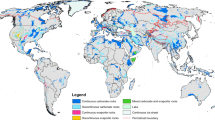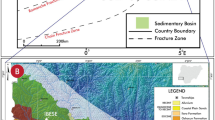Abstract
The Konya plain in south central Anatolia, Turkey, which is now largely dry, was occupied around the time of the Last Glacial Maximum by a fresh-oligosaline lake covering more than 4000 km2. Sediment cores from three residual water bodies (Pinarbaşi, Akgöl and Süleymanhaci) within the larger Pleistocene lake basin, have been analysed using a multidisciplinary approach. The sediment sequences are dated as spanning the last 50 Ka years, although breaks in sedimentation mean that there is only partial chronological overlap between them. Carbon and oxygen isotope analyses on lacustrine carbonate from the three cores give contrasting isotope profiles which reflect the different ages and independent hydrological behaviour of different sub-basins through the late Quaternary. Distinguishing changes that are regional from local effects is aided by modern isotope hydrology studies and by comparing the carbonate δ13C and δ18O values to diatom and other analyses undertaken on the same cores.
Similar content being viewed by others
References
Andrews, J. E., R. Riding & P. F. Dennis, 1993. Stable isotope compositions of recent freshwater cyanobacterial carbonates from the British Isles: local and regional environmental controls. Sedimentology 40: 303–314.
Andrews, J. E., R. Riding & P. F. Dennis, 1997. The stable isotope record of environmental and climatic signals in modern terrestrial microbial carbonates from Europe. Palaeogeogr. Palaeoclimatol. Palaeoecol. 129: 171–189.
Battarbee, R. W., 1986. Diatom analysis. In Berglund, B.E. (ed.) Handbook of Holocene palaeoecology and palaeohydrology. John Wiley, Chichester.
Bottema, S. & H. Woldring, 1984. Late Quaternary vegetation and climate of southwestern Turkey II. Palaeohistoria 26: 123–149.
Brady, G. S. & A. M. Norman, 1896. A monograph of the marine and freshwater Ostracoda of the North Atlantic and of northwestern Europe. Sections II-V: Myodocopa, Cladocopa, Platycopa. Sci. Trans. R. Dublin Soc. Series 2, 5: 621–784.
Cerling, T. E., J. R. Bowman & J. R. O'Neil, 1988. An isotopic study of a fluvial-lacustrine sequence: the Plio-Pleistocene Koobi Fora sequence, East Africa. Palaeogeogr. Palaeoclimatol. Palaeoecol. 63: 335–356.
Curry, B. B., T. F. Anderson & K. C. Lohmann, 1997. Unusual carbon and oxygen isotopic ratios of ostracodal calcite from last interglacial (Sangamon episode) lacustrine sediment in Raymond Basin, Illinois, USA. J. Paleolim. 17: 421–435.
Danielopol, D. L. & K. G. McKenzie, 1977. Psychrodromus gen. n. (Crustacea, Ostracoda), with redescription of the cypridid genera Prionocypris and Ilyodromus. Zoologica Scripta 6: 301–322.
Dansgaard, W., 1964. Stable isotopes in precipitation. Tellus 16:436–468.
Dean, W. E., 1974. Detection of carbonate and organic matter in calcareous sediments and sedimentary rocks by loss on ignition. Chem. Geol. 44: 151–185.
Driessen, P. M. & A. L. van der Linden, 1970. Hydrology and salinity. In de Meester, T. (ed.) Soils of the Great Konya Basin, Turkey. Centre for Agricultural Publishing and Documentation, Wageningen, Netherlands.
Drummond, C. N., W. P. Patterson & J. C. G. Walker, 1995. Climatic forcing of carbon-oxygen isotopic covariance in temperateregion marl lakes. Geology 23: 1031–1034.
Durand, A., J. Ch. Fontes, F. Gasse, M. Icole & J. Lang, 1984. Le nord-ouest du Lac Tchad au Quaternaire: étude de paléoenvironments alluviaux, eoliens, palustres et lacustres. Palaeoecol. Africa 16: 215–243.
Eicher, U. & U. Siegenthaler, 1976. Palynological and oxygen isotope investigations on Late-Glacial sediments cores from Switzerland. Boreas 5: 109–117.
Gasse, F. & J. C. Fontes, 1989. Palaeoenvironments and palaeohydrology of a tropical closed lake (Lake Asal, Djibouti) since 10000 yr BP. Palaeogeogr. Palaeoclimatol. Palaeoecol. 69: 67–102.
Gasse, F., S. Juggins & L. Ben Khelifa, 1995. Diatom-based transfer functions for inferring past hydrochemical characteristics of African lakes. Palaeogeogr. Palaeoclimatol. Palaeoecol. 117: 31–54.
Heaton, T. H. E., J. A. Holmes & N. D. Bridgewater, 1995. Carbon and oxygen isotope variations among lacustrine ostracods: implications for palaeoclimatic studies. Holocene 5(4): 428–434.
Holmes, J. A., F. A. Street-Perrott, M. J. Allen, P. A. Fothergill, D. D. Harkness, D. Kroon & R. A. Perrott, 1997. Holocene palaeolimnology of Kajemarum Oasis, Northern Nigeria: an isotopic study of ostracodes, bulk carbonate and organic carbon. J. Geol. Soc. London 154: 311–319.
Hillaire-Marcel, C & J. Casanova, 1987. Isotopic hydrology and palaeohydrology of the Magadi (Kenya)-Natron (Tanzania) basin during the late Quaternary. Palaeogeogr. Palaeoclimatol. Palaeoecol. 58: 155–181.
Hudson, J. D., 1977. Stable isotopes and limestone lithification. J. Geol. Soc. London 133: 637–660.
Karabiyikoglu, M., C. Kuzucuoglu, M. Fontugne, D. Mouralis & S. Babayigit, (in press). Depositional environments and sequence stratigraphy of a coarse grained, Late Pleistocene lake shoreline system in the Konya Basin, southern central Anatolia: lake level changes and climatic implications. Quat. Sci. Rev.
Li, H.-C. & T.-L. Ku, 1997. δ13C-δ18O covariance as a paleohydrological indicator for closed-basin lakes. Palaeogeogr. Palaeoclimatol. Palaeoecol. 133: 69–80.
McCrea, J. M., 1950. On the isotopic chemistry of carbonates and palaeo-temperature scale. J. Chem. Phys. 18: 849–857.
McKenzie, J. A., 1985. Carbon isotopes and productivity in the lacustrine and marine environment. In W. Stumm (ed). Chemical Processes in Lakes. Wiley, New York.
de Meester, T. (ed)., 1970. Soils of the Great Konya basin, Turkey. Wageningen: Centre for Agricultural Publishing and Documentation
Meisch, C., (in prep). Freshwater Ostracoda of western and central Europe.
Menking, K. M., J. L. Bischoff, J. A. Fitzpatrick, J. W. Burdette & R. O. Rye, 1997. Climatic/hydrologic oscillations since 155,000 yr BP at Owens Lake, California, reflected in abundance and stable isotope compositions of sediment carbonate. Quat. Res. 48: 58–68.
O'Neil, J. R., R. N. Clayton & T. K. Mayeda, 1969. Oxygen isotope fractionation in divalent metal carbonates. J. Chem. Phys. 51: 5547–5558.
Reed, J. M., N. Roberts & M. J. Leng, (in press). Late Quaternary palaeolimnological and climate change in two lakes of contrasting hydrology in the Konya Basin, Turkey. Quat. Sci. Rev.
Rindsberger, M., M. Magaritz, I. Carmi & D. Gilad, 1983. The relationship between air mass trajectories and the water isotope composition of rain in the Mediterranean Sea area. Geophys. Res. Lett. 10: 43–46.
Roberts, N., 1983. Age, palaeoenvironments and climatic significance of Late Pleistocene Konya lake, Turkey. Quat. Res. 19: 154–171.
Roberts, N., S. Black, P. Boyer, W. J. Eastwood, H. I. Griffiths, H. F. Lamb, M. J. Leng, R. Parish, J. M. Reed, D. Twigg & H. Yigitbasioglu, (in press). Chronology and stratigraphy of Late Quaternary sediments in the Konya Basin, Turkey: results from the KOPAL Project. Quat. Sci. Rev.
Romanek, C. S., E. L. Grossman & J. W. Morse, 1992. Carbon isotopes fractionation in synthetic aragonite and calcite: effects of temperature and precipitation rate. Geochim. Cosmochim. Acta 56: 419–430.
Schoell, M., 1978. Stable isotope analyses on authigenic carbonates from Lake Van sediments and their possible bearing on the climate of the past 10,000 years. In E.T. Degens and F. Kurtman (eds). The Geology of Lake Van. MTA Press, Ankara.
Siegenthaler, U. & U. Eicher, 1986. Stable oxygen and carbon isotope analyses. In Berglund, B.E. (ed.). Handbook of Holocene Paleoecology and Palaeohydrology, 407–422. Wiley, London.
Stiller, M. & G. E. Hutchinson, 1980. The waters of Merom: A study of Lake Huleh. Arch. Hydrobiol. 89(3): 275–302.
Spencer, R. J., M. J. Baedecker, H. P. Eugster, R. M. Forester, M. B. Goldhaber, B. F. Jones, K. Kelts, J. McKenzie, D. B. Madsen, S. L. Rettig, M. Rubin & C. J. Bowser, 1984. Great Salt Lake, and precursors, Utah: the last 30,000 years. Contrib. Min. Petrol. 86: 321–334.
Talbot, M. R., 1990. A review of the palaeohydrological interpretation of carbon and oxygen isotopic ratios in primary lacustrine carbonates. Chem. Geol. (Isotopes Geoscience Section) 80: 261–79.
Talbot, M. R. & T. Johannessen, 1992. A high resolution palaeoclimatic record for the last 27,500 years in tropical West Africa from the carbon and nitrogen isotopic composition of lacustrine organic matter. Earth Planetary Sci. Lett. 110: 23–37.
Talbot, M. R. & K. Kelts, 1986. Primary and diagenetic carbonates in the anoxic sediments of Lake Bosumtwi, Ghana. Geology 14: 912–916.
Tarutani, T., R. N. Clayton & T. Mayeda, 1969. The effect of polymorphism and magnesium substitution on oxygen isotope fractionation between calcium carbonate and water. Geochim. Cosmochim. Acta 33: 987–996.
von Grafenstein, U., H. Erlenkeuse, H. Kleinmann, J. Muller & P. Trimborn, 1994. High frequency climate oscillations during the last deglaciation as revealed in oxygen isotope records of benthic organisms (Ammersee, southern Germany). J. Paleolim. 11: 349–357.
Wefer, G. & W. H. Berger, 1991. Isotope paleontology: growth and composition of extant calcareous species. Marine Geol. 100: 207–248.
Xia, J., E. Ito & D. R. Engstrom, 1993. Oxygen isotope composition of lacustrine ostracodes as palaeoclimate indicator. EOS, Trans. Am. Geophys. Union 74: 365.
Xia, J., D. R. Engstrom & E. Ito, 1997a. Geochemistry of ostracode calcite: Part 2. The effects of water chemistry and seasonal temperature variation on Candona rawsoni. Geochim. Cosmochim. Acta 61(2): 383–391.
Xia, J., E. Ito & D. R. Engstrom, 1997b. Geochemistry of ostracode calcite: Part 1: An experimental determination of oxygen isotope fractionation. Geochim. Cosmochim. Acta 61(2): 377–382.
Yurtsever, Y., 1975, Worldwide survey of stable isotopes in precipitation. IAEA, Vienna, Rep., report, Sect. Isot. Hydrol., 53pp.
Author information
Authors and Affiliations
Rights and permissions
About this article
Cite this article
Leng, M.J., Roberts, N., Reed, J.M. et al. Late Quaternary palaeohydrology of the Konya Basin, Turkey, based on isotope studies of modern hydrology and lacustrine carbonates. Journal of Paleolimnology 22, 187–204 (1999). https://doi.org/10.1023/A:1008024127346
Issue Date:
DOI: https://doi.org/10.1023/A:1008024127346




